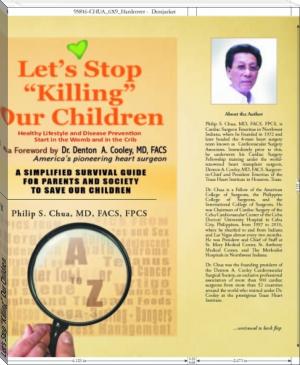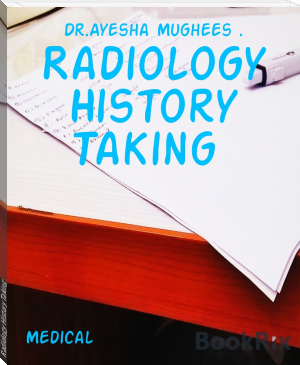Effects of Radio-chemotherapy in Cancer Patients by Muhammad Younis, Sana Shaikh (good books to read in english txt) 📖

- Author: Muhammad Younis, Sana Shaikh
Book online «Effects of Radio-chemotherapy in Cancer Patients by Muhammad Younis, Sana Shaikh (good books to read in english txt) 📖». Author Muhammad Younis, Sana Shaikh
FATS AND OILS:
Most fats/oils should be kept to a minimum especially if they are human made or over processed (corn oil is deadly, margarine even more so), though you will want to get your allotment of Omega-3s. [17] Fats have probably been studied most thoroughly and produced the greatest association with cancer. [18] Avoid heating oils; heat causes oxidation and the release of free radicals. Mayonnaise and margarine are out. Avoid trans fatty (partially hydrogenated) oils as if they were the cause of your cancer. In 1989, the USDA found that fish oils reduce the production of the prostaglandin E2 which has a tendency to cause appetite loss. It is this appetite loss that brings on cachexia, the wasting syndrome that causes eventual death in cancer patients. [17]
SUGARS (CARBOHYDRATES):
The principles of carbohydrate in foods are sugar, cellulose and starch. There is a little role of carbohydrate pertaining to cancer. [18] Cancer loves sugar and your liver hates it. Sugars put a terrible strain on your liver. The only recommended sweetener is Stevia. Stevia has been used for decades with no side effects. [17] In multiple studies diabetes has been linked with increased risk of colorectal cancer [19-21], endometrial cancer [22], and pancreatic cancer [20][23]. It is clear that severe dysregulation of glucose metabolism is a risk factor for cancer. Foods that contribute to hyperinsulinemia, such as refined sugar, foods containing refined sugar, and refined flour products should be avoided and eliminated from a cancer-protective diet. [24] LOW FIBER DIET: Unrefined plant foods typically have an abundance of fiber. Dairy products, eggs, and meat all have this in common – they contain no fiber. Refined grain products also have most of the dietary fiber removed from them. So, a diet high in animal products and refined grains (a typical diet in the USA) is low in fiber. In prospective health studies, low fiber was not found to be a risk for breast cancer. [24] A threshold of about 5 daily servings of vegetables was needed to reduce cancer risk and the effect was stronger among older subjects. [25] A high fiber/low-fat diet is a cancer preventer and fighter. Fiber cleans your colon and combines with "stuck" fats to pass them on. It helps to lower cholesterol and tones your entire digestive tract. The connection between low fiber intake and colon cancer has long been established. [17] RED MEAT:
It has been suggested that high consumption of red meat might be associated with an increased risk of colon cancer. Components of cooked meat that have been suggested to cause this include heterocyclic amines, polycyclic aromatic hydrocarbons, nitrogenous residues, and iron. Currently, the extent of any association remains unclear and it is unknown whether there is a link with red meat specifically or just with processed meat.[15] Meat, and the heterocyclic amines formed in cooking, have been correlated to breast cancer in a case-control study in Uruguay as well.[26]
ALCOHOL:
People who drink large amounts of alcohol have an increased risk of certain types of cancer, particularly liver cancer and cancers in the mouth and oesophagus. If such people also smoke, this makes the risk of cancer even greater. [15]
SELENIUM:
Selenium is a mineral with anti-cancer properties. Many studies in the last several years have shown that selenium is a potent protective nutrient for some forms of cancer. [27] Selenium is present in the active site of many enzymes, including thioredoxin reductase, which catalyzes oxidation-reduction reactions. These reactions may encourage cancerous cells to under apoptosis. Selenium can decrease the rate of tumor growth. [28][29] Both men and women were found to be protected by higher levels of selenium from colon cancer [30] and lung cancer.[31][32
PROTECTIVE VITAMINS:
Vitamin B-12:
Vitamin B-12 has not been proven to be an anti-cancer agent, but there is some evidence indicating that it could be beneficial. The form of administered vitamin B-12 may be important. [33] So, there is evidence from laboratory studies, prospective cohort studies, and mechanistic studies showing that vitamin B-12 is an important nutrient for genetic stability, DNA repair, carcinogenesis, and cancer therapy. [34]
FOLIC ACID: Folic acid is the dark green leafy vegetable vitamin. It has an integral role in DNA methylation and DNA synthesis. Folic acid works in conjunction with vitamin B-6 and vitamin B-12 in the single carbon methyl cycle. If insufficient folic acid is not available uracil is substituted for thymidine in DNA, which leads to DNA strand breakage. Many studies have found a significant reduction in the colon, rectal, and breast cancer with higher intakes of folic acid and their related nutrients (vitamin B-6 and B-12). Alcohol is an antagonist of folate, so that drinking alcoholic beverages greatly magnifies the cancer risk of a low-folate diet. [34]
VITAMIN D:
Vitamin D is produced primarily from the exposure of the skin to sunshine. Even casual exposure of the face, hands, and arms in the summer generates a large amount of vitamin D. [35] The concentration of the active hormonal form of vitamin D is tightly regulated in the blood by the kidneys. This active hormonal form of vitamin D has the potent anti-cancer properties. It has been discovered that various types of normal and cancerous tissues. Several prospective studies of vitamin D and cancer have also shown a protective effect of vitamin D. [36]
ANTIOXIDANTS:
α- andβ-Carotene and other Carotenoids:
Carotenoids have been studied vigorously to see if these colorful compounds can decrease cancer risk. In ecological studies and early case-control studies, it appeared thatβ-carotene was a cancer-protective agent. [37] Alpha-carotene has been found to be a stronger protective agent than its well-known isomerβ-carotene. Studies tend to agree that the overall intake of carotenoids is more protective than a high intake of a single carotenoid. So, a variety of fruits and vegetables is still a better anti-cancer strategy than just using a single vegetable high in a specific carotenoid. The richest source ofα-carotene is carrots and carrot juice, with pumpkins and winter squash as a second most-dense source. [38][39]
VITAMIN C:
Vitamin C is correlated with overall good health and cancer prevention. [40] Use of vitamin C for cancer therapy was popularized by Linus Pauling. At high concentrations, ascorbate is preferentially toxic to cancer cells. There is some evidence that large doses of vitamin C, either in multiple divided oral doses or intravenously, have beneficial effects in cancer therapy. [41][42]
OTHER ANTIOXIDANTS:
There are many more substances that will have some benefit for cancer therapy. Most of these substances are found in foods, but their effective doses for therapy are much higher than the normal concentration in the food. For example, grape seed extract contains proanthocyanidin, which shows anticarcinogenic properties. Also, green tea contains a flavanol, epigallocatechin-3-gallate (EGCG), which can inhibit metalloproteinases, among several possible other mechanisms. [43]
FOOD CARCINOGEN:
Carcinogens are substances that can start the process of cancer. Tobacco smoke contains carcinogens that cause lung cancer. Foods may also contain carcinogens. However, the risk from carcinogens in foods is low because if they are present at all, it is usually in very small amounts. Carcinogens in foods may be substances that occur naturally, they may be due to contamination, or they are formed during cooking or processing (e.g. in smoked foods or foods that have been blackened during cooking e.g. barbecuing). Aflatoxins are examples of carcinogens present in poorly stored foods. They areinked to mouldy produce, especially peanuts that are contaminated by the growth of molds.[15]
GRAINS
Twenty percent of your diet should be whole grains. Avoid all refined, polished grains and flours and products made from them. Brown rice, kashi, millet, rye, buckwheat, barley, oats and oat bran’s, corn (on the cob or corn grits), and quinoa are recommended. [17]
1.9. TREATMENT ] Cancer can develop at many different sites around the body, the general principles of treatment are the same. The chances of cancer being curable are highest if it is detected by screening at a sufficiently early stage before it causes symptoms. .Cancer can be treated by surgery, chemotherapy, radiation therapy, immunotherapy, monoclonal antibody therapy or other methods. The choice of therapy depends upon the location and grade of the tumor and the stage of the disease, as well as the general state of the patient. A number of experimental cancer treatments are also under development. [45] In most cases, curative treatment involves the surgical removal of a tumour.Surgery Surgical removal of a tumor is the main treatment for most common solid tumors at an early stage. Mainly cancer chemotherapy and radiation therapy are used to damage or kill cancer cells. Some of the body’s normal cells, including the blood cells, may also damaged by these treatments. Some medicines can also slow down the making of the blood cells [46].
RADIOTHERAPY
Radiation therapy is one of several treatments used to treat cancer by itself or in combination with other forms of treatment, most often surgery or chemotherapy. Radiation therapy is also called radiotherapy. [47] Radiation exposure to X-rays or gamma rays can kill cells or stop their growth. It can be effective in the treatment of cancerous growths because malignant cells are more sensitive than normal body cells: the radiation can be applied to a particular area, whilst the rest of the body is shielded from it.
Historically, radiotherapy dates back to the discovery of X-rays by Röntgen in 1895 and of the radioactivity of substances such as uranium by Becquerel in 1896, leading to that of radium, identified in 1898 by Marie and Pierre Curie. [48] If your tumor is in a position that makes surgery too risky to perform, radiotherapy may be used as the first line of treatment, usually in combination with chemotherapy. For some people with low-grade gliomas, these treatments may be offered soon after diagnosis; for others, it could be that their tumors are stable enough for years to pass by on the “watch and live” treatment plan of regular MRI scans before any radiotherapy is offered.[49]
Radiation therapy injures or destroys cells in the area being treated (the “target tissue”) by damaging their genetic material, making it impossible for these cells to continue to grow and divide. Although radiation damages both cancer cells and normal cells, most normal cells can recover from the effects of radiation and function properly. [50]
Goals of radiation therapy:
1: The goal of radiation therapy is to damage as many cancer cells as possible, while, limiting harm to nearby healthy tissue. 2: We design methods to focus X-rays on specific tumors or regions of the body. [51] 3: the aim is to shrink a tumor and relieve symptoms. [50]
Types of radiation therapy:
There are different types of radiation and different ways to deliver the radiation.





Comments (0)